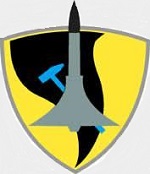Hobby Master HA4502 Israeli Defense Force Boeing F-15I Raam Strike Eagle Multi-Role Fighter - 69 Hammers Squadron, Hatzerim, Israel, 2009 (1:72 Scale)
"Obsolete weapons do not deter."
- British Prime Minister Margaret Thatcher
 The McDonnell Douglas (now Boeing) F-15E Strike Eagle is an all-weather multirole fighter, derived from the McDonnell Douglas F-15 Eagle. The F-15E was designed in the 1980s for long-range, high speed interdiction without relying on escort or electronic warfare aircraft. United States Air Force (USAF) F-15E Strike Eagles can be distinguished from other U.S. Eagle variants by darker camouflage and conformal fuel tanks mounted along the engine intakes.
The McDonnell Douglas (now Boeing) F-15E Strike Eagle is an all-weather multirole fighter, derived from the McDonnell Douglas F-15 Eagle. The F-15E was designed in the 1980s for long-range, high speed interdiction without relying on escort or electronic warfare aircraft. United States Air Force (USAF) F-15E Strike Eagles can be distinguished from other U.S. Eagle variants by darker camouflage and conformal fuel tanks mounted along the engine intakes.
The Strike Eagle has been deployed in Operation Desert Storm, Operation Allied Force, Operation Enduring Freedom, and Operation Odyssey Dawn carrying out deep strikes against high-value targets, combat air patrols, and providing close air support for coalition troops. It has also seen action in later conflicts and has been exported to several countries.
The F-15E will be upgraded with the Raytheon APG-82 Active Electronically Scanned Array (AESA) radar after 2007, and the first test radar was delivered to Boeing in 2010. It combines the processor of the APG-79 used on the F/A-18E/F Super Hornet with the antenna of the APG-63(V)3 AESA being fitted on the F-15C. The new radar upgrade is to be part of the F-15E Radar Modernization Program. The new radar was named APG-63(V)4 until it received the APG-82 designation in 2009. The RMP also includes a wideband radome (to allow the AESA to operate on more radar frequencies), and improvements to the environment control and electronic warfare systems.
While some of the F-15C/Ds have been replaced by the F-22 Raptor, there is no slated replacement for the F-15E in its primary "deep strike" mission profile. The Strike Eagle is a more recent variant of the F-15, and has a sturdier airframe rated for twice the lifetime of earlier variants. The F-15Es are expected to remain in service past 2025. The USAF has pursued the Next-Generation Bomber, a medium bomber concept which could take over the Strike Eagle's "deep strike" profile. The F-35A Lightning II is projected to eventually replace many other attack aircraft such as the F-16 Fighting Falcon and A-10 Thunderbolt II, and may also take over much of the F-15E's role; however, the F-15E has better combat range under payload.
Pictured here is a stunning 1:72 scale diecast replica of an Israeli Air Force Boeing F-15I Ra'am Strike Eagle multi-role fighter that was attached to the 69 Hammers Squadron, then deployed to Hatzerim, Israel, during 2009.
Sold Out!
Dimensions:
Wingspan: 7-inches
Length: 10-1/2-inches
Release Date: December 2014
 Historical Account: "Thunder" - The F-15I is operated by the Israeli Air Force where it is known as the Ra'am (רעם "Thunder"). It is a dual-seat ground attack aircraft powered by two Pratt & Whitney F100-PW-229 engines, and is based on the F-15E.
Historical Account: "Thunder" - The F-15I is operated by the Israeli Air Force where it is known as the Ra'am (רעם "Thunder"). It is a dual-seat ground attack aircraft powered by two Pratt & Whitney F100-PW-229 engines, and is based on the F-15E.
The F-15I Ra'am is similar to the F-15E, but features several different avionic systems to meet Israeli requirements. To facilitate night-time strikes, the F-15Is were initially fitted with Sharpshooter targeting pods designed for Israeli F-16s. The Sharpshooter pod was less capable than the LANTIRN pods used on USAF F-15Es; Israel later purchased 30 LANTIRN pods. The F-15Is initially lacked Radar Warning Receivers, thus Israel installed its own electronic warfare equipment, the Elisra SPS-2110, as well as a new central computer and embedded GPS/INS system. All sensors can be slaved to the Display And Sight Helmet (DASH) helmet-mounted sight, providing both crew members a means of targeting which the F-15E lacks. The F-15I uses the APG-70I radar; its terrain mapping capability can be used to locate targets that are otherwise difficult to spot - e.g., missile batteries, tanks and structures - in adverse conditions such as heavy fog or rain. The radar can detect large airliner-sized targets at 150 nautical miles, and fighter-sized targets at 56 nautical miles, although it has a reduced resolution one-third below the standard USAF APG-70.


